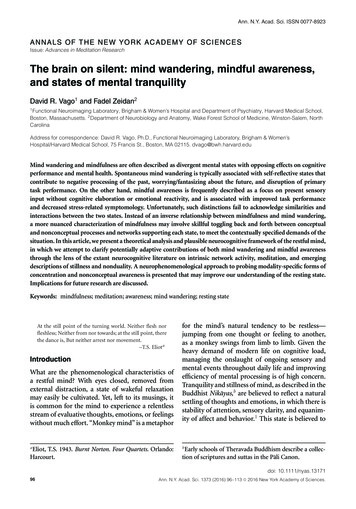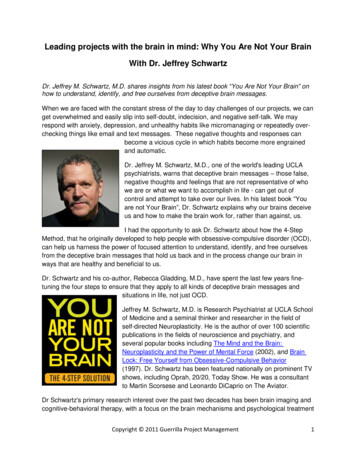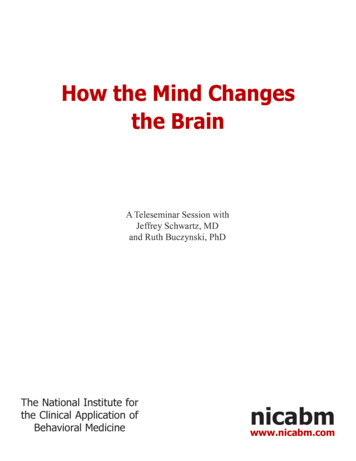
Transcription
Ann. N.Y. Acad. Sci. ISSN 0077-8923A N N A L S O F T H E N E W Y O R K A C A D E M Y O F SC I E N C E SIssue: Advances in Meditation ResearchThe brain on silent: mind wandering, mindful awareness,and states of mental tranquilityDavid R. Vago1 and Fadel Zeidan21Functional Neuroimaging Laboratory, Brigham & Women’s Hospital and Department of Psychiatry, Harvard Medical School,Boston, Massachusetts. 2 Department of Neurobiology and Anatomy, Wake Forest School of Medicine, Winston-Salem, NorthCarolinaAddress for correspondence: David R. Vago, Ph.D., Functional Neuroimaging Laboratory, Brigham & Women’sHospital/Harvard Medical School, 75 Francis St., Boston, MA 02115. dvago@bwh.harvard.eduMind wandering and mindfulness are often described as divergent mental states with opposing effects on cognitiveperformance and mental health. Spontaneous mind wandering is typically associated with self-reflective states thatcontribute to negative processing of the past, worrying/fantasizing about the future, and disruption of primarytask performance. On the other hand, mindful awareness is frequently described as a focus on present sensoryinput without cognitive elaboration or emotional reactivity, and is associated with improved task performanceand decreased stress-related symptomology. Unfortunately, such distinctions fail to acknowledge similarities andinteractions between the two states. Instead of an inverse relationship between mindfulness and mind wandering,a more nuanced characterization of mindfulness may involve skillful toggling back and forth between conceptualand nonconceptual processes and networks supporting each state, to meet the contextually specified demands of thesituation. In this article, we present a theoretical analysis and plausible neurocognitive framework of the restful mind,in which we attempt to clarify potentially adaptive contributions of both mind wandering and mindful awarenessthrough the lens of the extant neurocognitive literature on intrinsic network activity, meditation, and emergingdescriptions of stillness and nonduality. A neurophenomenological approach to probing modality-specific forms ofconcentration and nonconceptual awareness is presented that may improve our understanding of the resting state.Implications for future research are discussed.Keywords: mindfulness; meditation; awareness; mind wandering; resting stateAt the still point of the turning world. Neither flesh norfleshless; Neither from nor towards; at the still point, therethe dance is, But neither arrest nor movement.–T.S. EliotaIntroductionWhat are the phenomenological characteristics ofa restful mind? With eyes closed, removed fromexternal distraction, a state of wakeful relaxationmay easily be cultivated. Yet, left to its musings, itis common for the mind to experience a relentlessstream of evaluative thoughts, emotions, or feelingswithout much effort. “Monkey mind” is a metaphoraEliot, T.S. 1943. Burnt Norton. Four Quartets. Orlando:Harcourt.for the mind’s natural tendency to be restless—jumping from one thought or feeling to another,as a monkey swings from limb to limb. Given theheavy demand of modern life on cognitive load,managing the onslaught of ongoing sensory andmental events throughout daily life and improvingefficiency of mental processing is of high concern.Tranquility and stillness of mind, as described in theBuddhist Nikāyas,b are believed to reflect a naturalsettling of thoughts and emotions, in which there isstability of attention, sensory clarity, and equanimity of affect and behavior.1 This state is believed tobEarly schools of Theravada Buddhism describe a collection of scriptures and suttas in the Pāli Canon.doi: 10.1111/nyas.1317196C 2016 New York Academy of Sciences.Ann. N.Y. Acad. Sci. 1373 (2016) 96–113
Vago & Zeidandevelop through systematic mental training involving a combination of concentration, nonconceptualobservation, and discernment.2–4Although the majority of research on brain function has focused on task-evoked activity, currentresearch focusing on the task-unrelated restingmind–brain is beginning to reveal the critical importance of this largely ignored part of human life. Sincethe advent of neurophysiological recording, it hasbeen determined that the brain is never truly resting.Hans Berger first observed that all states of wakefulness and sleep reveal a spectrum of mixed amplitudes and frequencies of electrical activity that doesnot cease. According to thought-sampling studiesduring mind wandering,5–7 the content of the restless mind is often incredibly rich and self-relevant,characterized by spontaneous thoughts and emotions concerned with the past and hopes, fears, andfantasies about the future, often including interpersonal feelings, unfulfilled goals, unresolved challenges, and intrusive memories. With respect tocost and benefit, research on the “resting state”is demonstrating how task-unrelated or stimulusindependent thought (SIT) may adaptively organize brain function8 and how the intrinsic neuralactivity supporting SIT affects brain metabolismand neuroplasticity.8–11 Although there are certainlybenefits to having access to the rich landscape ofspontaneous thoughts for the purpose of creativeincubation,7,12 problem solving,6 and goal setting,13an inability to focus attention in the face of irrelevant distraction by such thoughts can be problematic. Unfortunately, humans have been shown toexperience this intrinsic undercurrent of spontaneous, self-generated thought during ongoing taskdemands as a form of interference, distraction,or rumination approximately 50% of each wakingday.5,14 SIT often interferes with the ability to remainexternally vigilant,15,16 remain focused or concentrate on the task at hand,16 properly encode externalinformation,17 listen,18 perform,16,19 or even sleep.20In addition to the apparent inefficiency that SITcontributes to daily life, there is now a large literature linking a majority of self-generated thoughtto negatively valenced content and negative moodstates,21,22 future unhappiness,5 and the maintenance of psychopathology, such as generalized anxiety disorder23–25 or major depressive disorder.26,27Most recently, there has been interest in exploring how particular forms of mental training thatThe brain on silentinclude a state of mindful awareness allow individuals to change the relationship with the resting stateand experience the stream of stimulus-independentmental content in an adaptive way.28–30Mindfulness and mind wandering are oftendescribed as two divergent mental states;31,32 yet,both are frequently referenced in the context of mental rest. There is a subtle difference in both awarenessand engagement with the flow of mental objects thatmay determine the adaptive or maladaptive natureby which the mental content influences one’s currentmood and future behavior (Fig. 1). Currently, thereis great interest in better understanding the neural mechanisms that support resting-state dynamics, states of mindful awareness, and their respectivecontributions to mood and cognition (see Refs. 31and 32). In this article, we examine a more nuancedperspective on particular mental states that reflect“rest,” mental quiet, stimulus independence, andthe neurobiological and physiological circuitry supporting the various flavors of what may constitutea “restful mind.” Occasionally, references are madeto the historical Buddhist literature for the purposeof exploring an epistemology of mind as it relates tocontemporary secular adaptations of the constructmindfulness.The (not-so) resting state: mind wandering,evaluation, and self-referential processingThe resting state is commonly referred to as thebaseline state of mind in quietly awake individuals and in the context of no particular task. Givenits task-negative orientation, the resting state hasbeen used as a functional contrast for most activetask-positive conditions in functional neuroimaging studies.33,34 In fact, this state has been used as acontrol or baseline condition against conditions ofinterest in an overwhelming number of neuroimaging studies, since such methods were introduced inthe early 1980s.33 The instructions for this passivebaseline state are frequently given in some variationof, “let your mind freely wander without thinking ofanything in particular,” “relax,” or “stay still and donothing,” and involve either eyes opened or closed;however, to avoid the occurrence of sleep, many protocols have encouraged the use of open eyes, with(and without) a fixation cross as a visual stimuluson which to rest one’s eyes.Interest in the resting state has mostly reflectedthe interest in the methodological functionC 2016 New York Academy of Sciences.Ann. N.Y. Acad. Sci. 1373 (2016) 96–113 97
The brain on silentVago & ZeidanFigure 1. Variations in awareness during meditation and mind-wandering rest. Visual (V), auditory (A), and somatic (S) modalitiesof experience are depicted. Awareness in the present moment is depicted by the blue band around mental objects arising and passingthrough time. Width of the band represents the temporal focus of awareness. The more temporally extended awareness is in time,the more mental stickiness and disengagement delays are apparent. Wider bands refer to difficulty disengaging from mental orsensory objects, greater projection into past or future experience, and a resulting smaller aperture. FA meditation focuses on onlyone mental/physical object in experience (somatic object is depicted here). All modalities of experience enter awareness in OMmeditation and mind wandering (MW). Variations in qualities of object orientation (engagement/disengagement), clarity, andaperture in experience are depicted. These three qualities are represented, respectively, by the width of the circles for each mentalobject, brightness of the fill color, and diameter of the ring of awareness that sits in the present moment of time. Adept meditatorsare believed to experience higher clarity (phenomenal intensity) in both forms of meditation, whereas MW is believed to representlow clarity or dullness. Low object orientation or engagement represents less mental stickiness and rapid disengagement, leavingavailable more cognitive resources. Aperture (scope of awareness) is believed to be intentionally narrow for a concentration practiceand high for OM practice. In MW, the spotlight of attention is typically narrow and unintentional because of increased engagementwith each mental object; resources are subsequently depleted. Adapted, with permission, from Farb et al.27 and Lutz et al.124 SeeLutz et al.124 for more extensive descriptions of clarity and aperture, as well as for other potential experiential descriptors relevantto mindfulness.by which to probe spontaneous low-frequency( 0.1 Hz) blood oxygen level–dependent (BOLD)fluctuations (LFBF) that demonstrate consistentspatially and temporally coherent connectivityamong large-scale functional brain networks.35–38Across each of the variations in the abovementioned instructions, there is robust consistencyin detection of these networks, suggesting that lowlevel physiological noise, task load (fixation), eyemovement, or the presence of visual input cannotinfluence the results.39 Furthermore, these large98scale intrinsic resting-state networks (RSNs) appearto reflect a fundamental aspect of the brain’s organization and are consistently apparent across waking states, including task performance, sleep,40 andeven general anesthesia.41 At least 10 organizedRSNs have been identified during rest, includingthe default mode network (DMN; Fig. 2), with eachone reflecting specific functions that cohere to theintrinsic connectivity patterns (i.e., language, attention, executive functioning, salience, sensorimotoractivity, or mind wandering).42–45C 2016 New York Academy of Sciences.Ann. N.Y. Acad. Sci. 1373 (2016) 96–113
Vago & ZeidanThe brain on silentFigure 2. RSN partition and global fc variability of other networks with the frontoparietal network (FPN). (A) Shown is thenetwork partition of 264 putative functional regions in 10 major RSNs identified at rest through independent component analysis.(B) The connectivity between the FPN and all other RSNs and associated mean variable connectivity are shown. The FPN is believedto act as a hub to enhance connectivity between all other RSNs. Adapted, with permission, from Cole et al.45A critical consideration in the interpretation ofspontaneous LFBF is the extent to which it is dueto specific functional behavior or mentation. Thereis evidence that varied mental content during theresting time period can modulate functional activity across RSNs, suggesting content has an effecton functional variations in LFBF.46,47 This wouldseem plausible given that people are engaged inunconstrained mind wandering while laying quietlyawake in a magnetic resonance imaging (MRI) scanner, with a variety of mental content to account forlow-level task activation.47 Yet, there are a numberof arguments38 supporting the idea that mentationduring mind wandering is unlikely to be the dominant source of LFBF.38 Nevertheless, task relevanceis often difficult to determine with SIT, unless it isin direct contrast to some attentionally demandingtask. Mental content during mind wandering mayindeed be of critical importance to task-related processing (e.g., memory consolidation, prospection)or to other ongoing processes that are fundamentalto self-specificity.14,48,49 Spontaneous fluctuationsfound in RSNs are believed to be regulated differently than task- or stimulus-driven brain activity.One popular theory holds that the intrinsic activityfrom LFBF may be more closely related to longrange coordination of higher frequency electricalactivity that facilitates coordination and organization of information processing across several spatiotemporal ranges.50,51 Metabolic demands at restalso do not suggest a strong correlation with cellularactivity;8,10,51 yet, the resting state does not reflecta zero-activity physiological baseline from whichattention manifests.The resting state has historically been referred toas the default mode, because it has been thought toreflect the dominant mode by which coordinatedintrinsic activity ongoing at rest is defaulted to,and to which it returns when attentional demandscease.8 Despite its regular occurrence, not all mindswander to the same degree; there are stable differences among individuals in the propensity to experience SIT and engage the DMN.14,52 Nevertheless,the reciprocal relationship between the passive tasknegative state of rest and the active task-positivestates is thought to support two fundamentallydifferent modes of information processing—oneserving internally oriented attention and anotherserving externally oriented attentional demands.The DMN shows the most robust anticorrelationwith attentional networks, apparent during externally oriented tasks, suggesting that it is fueling tasknegative internally directed functional activity.The DMN, also described as the hippocampal–cortical memory system,53,54 has most consistentlybeen shown to include the ventral posteromedialcortex (vPMC; including posterior cingulate cortex(PCC) and retrosplenial cortex), ventral medialprefrontal cortex (vmPFC), posterior inferiorparietal lobe (pIPL), hippocampus, and lateraltemporal lobe.36,39,55,56 The DMN has occasionallybeen reported to also include the dorsomedial/rostromedial PFC (including BA 8, 9, and 10),rostral anterior cingulate cortex (rACC, or anteriorC 2016 New York Academy of Sciences.Ann. N.Y. Acad. Sci. 1373 (2016) 96–113 99
The brain on silentVago & Zeidanmedial PFC), insular cortices, and temporalpole.52,57,58 Interestingly, these additional regionshave been implicated in task-positive networks andgoal-directed activity, suggesting possible overlap ofnetworks with potential functional relevance, andapparent nonstationarity or change over time seenin typical functional connectivity (fc) analyses.58Such observations of nonstationarity also suggest aproblem with implicating one network supportinga rapidly changing mental state at rest.47 In fact,some recent work has suggested that the DMN maybe broken into multiple subsystems that subservedifferent dimensions of stimulus-independent orstimulus-oriented mentalizing during the restingstate.52,59,60Notably, core DMN regions have been reported tosupport active states associated with self-reflective,evaluative processes in addition to supporting passive mental states of rest, further suggesting thatthe resting state involves internally oriented evaluative processing.36,52,61–63 Self-referential processinginvolves taking one’s self as the object of attentionand making judgments or evaluations of one’s ownthoughts, emotions, or character.34,57 These functional roles have provided the basis for the characterization of the DMN as an evaluative network andhas implicated the network in both spontaneousand volitionally mediated mind wandering.49 Theprimary nodes of the DMN (PCC and vmPFC) areparticularly noteworthy because of their anatomical connections and corresponding functional roles.For example, the vmPFC has direct anatomical connections to the hypothalamus, amygdala, striatum,and brainstem, providing input necessary to process emotion, motivational states, and arousal.64Its functional role in coordinating and evaluatingbasic drives associated with mood, reward, andgoal-directed behavior is also strongly supportedby the abovementioned anatomy and by its activityin functional brain imaging studies, animal experiments, and behavioral observations in patientswith vmPFC lesions.65,66 The PCC is considered tobe a network hub with dense anatomical connections across the brain and in particular with themedial temporal lobe, making it and neighboringregions of the vPMC well suited for mediating autobiographical memory retrieval and self-referentialprocessing.43,67 Recent studies have suggested thatvPMC activity may be functionally reduced to being“attached to” and “getting caught up in” one’s100experience, whether it be self- or other-focused, ornegatively or positively valenced.68 In this context,self-reflective processing consumes one’s cognitiveresources and interferes with ongoing task demandsand/or embodied behavior.A large body of research on the resting state nowsupports the involvement of the DMN in a diversearray of cognitive processes that are associatedwith negative or maladaptive mood states, such asrumination, craving, or distraction.14,34,68 There isevidence that, in most forms of psychopathology,the DMN is hyperactivated and hyperconnected,showing abnormally high activation during goaldirected tasks.34 These data suggest that taskdependent downregulation is not as apparentand that patients suffering from psychiatric disorders may be more easily distracted by internalruminations.69 Furthermore, greater suppression ofthe DMN during task performance has been shownto improve accuracy, memory encoding, retrieval,and consolidation.70–72 Greater DMN activation justprior to a stimulus predicts attentional lapses anddecreased accuracy, further providing evidence forits potential role in distraction.72 However, despitethe predominant interpretation that DMN activityis indicative of maladaptive functional processes,this interpretation may be overly simplistic. SIT andassociated DMN activity have been characterizedby content that is adaptive and constructive.6,57For example, in healthy individuals, SIT has beenshown to facilitate insight, creative problem solving,cognitive control, and prospection for simulatingfuture possible outcomes.12,22,73,74 The critical pointhere is that the costs and benefits of DMN activationare context dependent.14,75 Indeed, Smallwood andAndrews-Hanna14 proposed the context-regulationhypothesis, which states that self-generated thoughtunder conditions that demand continuous attention is unproductive because it can be a source oferror, but under nondemanding conditions, it hasthe potential for benefit.Although some may argue that there is noapparent functional relationship associated withspontaneous, intrinsic activation of the DMN, anargument can clearly be made claiming the benefitof spontaneous or intentional DMN activation as itreflects our sense of self-identity. DMN activationsupports conceptual, linguistic, and symbolic formsof self-representation involving a form of “mentaltime travel,” which explicitly provides a sense ofC 2016 New York Academy of Sciences.Ann. N.Y. Acad. Sci. 1373 (2016) 96–113
Vago & Zeidancoherence and continuity with our sense of self in thepresent moment by allowing one to project representations of self into the future and retrospectivelyto the past.14,76 Tulving76 described this mnemonicprocess involving episodic forms of autobiographical memory as “autonoetic consciousness,” suggesting a conceptual knowing and awareness of self inreal time. Tulving and others77–80 argued that thisuniquely human abilityc provides the necessary cognitive structure for advancing intelligence, building on existing knowledge, discriminating ethicaland adaptive behavioral responses to the environment, and “day dreaming” for advanced forms ofcognition. One could then imagine that, withoutopportunities to cultivate autonoetic consciousness,mistakes would be repeated, decisions would bepoorly informed, and a sense of identity would belacking. Mind wandering and the associated DMNactivity may, therefore, reflect intrinsic capacitiesthat are necessary to navigate the complex socialenvironment in which humans exist.14,81 Indeed,maintaining a sense of continuity of the self, withreliance on mnemonic processes and DMN activation, contributes to the highest functional andmetabolic demands of the brain during wakingstates.Mindful awareness: stillnessin concentrationFrom the classical Buddhist Abhidharma perspective, stability and stillness of mind provide freedomfrom destructive types of emotion and cognition(e.g., anger, craving, greed, lethargy, hyperexcitability) that are rooted in excessive self-absorption orperseveration.4,82 The following metaphor is commonly used to describe how the foundation ofmindfulness may contribute to the benefits of astill mind, focusing on cultivating attentional stability and reduced unintentional mind wandering.If a stone is tossed into a still lake, the ripples areclearly visible. Yet, when that lake is unsettled, a single stone’s effect is barely noticeable. The same iscAlthough Tulving argues that mental time travel isuniquely human, there is good evidence to suggest thatscrub jays can cache food in a manner that reflects bothplanning for the future and some form of mental timetravel to retrieve detailed information on when and wherethe food was cached.79The brain on silenttrue of the mind,83 in that a restless mind that isfraught with many thoughts and emotions is easily distracted, inefficient, and unable to adequatelyencode information for later retrieval. Furthermore,if one leaves a glass of muddy water still, withoutmoving it, the dirt will settle to the bottom, andthe clarity of the water will shine through. Similarly, in mindfulness-based meditation, in whichattention is trained to continually return to a single point of concentration, thoughts and emotionssettle into what is described as the mind’s natural state of stillness, ease, equanimity, and sensoryclarity.3,84In the text Stages of Meditation, an 8th century Indian Buddhist contemplative, Kamalasiladescribes 10 sequential stages of attention training,referred to as “taming the mind” or “calm abiding” (Pāli: samatha) that begins with an effortfulform of focused attention (FA) and progressivelyadvances toward a state of effortless and objectlessawareness.82 Stability of attention refers to sustainedconcentration and vigilance that remain unperturbed by distraction or interference from discursivemind wandering, while clarity refers to the phenomenal intensity with which sensory or mental contentis experienced.82,85 Insight practice (Pāli: vipassana),a form of open monitoring (OM) meditation, typically follows calm abiding training with the goalof facilitating meta-awareness of one’s own mentalhabits, increasing the aperture of awareness to allsensory and mental objects that naturally arise andpass. Mindfulness meditation is often taught as aninterplay between calm abiding and insight meditation. Therefore, according to the classical BuddhistAbhidharma, one depiction of a restful mind is onethat requires concentration, but is calm, alert, andholding an object or stream of objects in effortlessawareness.Although the breath is the most commonlydescribed object of focus in historical Buddhist contexts (e.g., Satipatthāna sutta), concentration maybe on any internal or external sensory object acrossmodalities, the temporal flow of objects arisingand passing through space/time, or the restful statewhere no objects are present (Table 1). One particular contemporary mindfulness system, the BasicMindfulness system,86 was developed by ShinzenYoung with multiple Buddhist traditions in mindand uses an algorithmic approach that teaches individuals to note and label any experience in threeC 2016 New York Academy of Sciences.Ann. N.Y. Acad. Sci. 1373 (2016) 96–113 101
The brain on silentVago & ZeidanTable 1. Objects of focus and modalities of mindful awareness (based on the Basic Mindfulness system)VisualAuditorySomaticSubjectivesensory activityObjectivesensory activitySensoryrestSensoryflowImage“See in”Talk“Hear in”Feeling“Feel in”Sight“See out”Sound“Hear out”Touch“Feel out”Blank“See rest”Quiet“Hear rest”Relaxation“Feel rest”Visual flow“See flow”Auditory flow“Hear flow”Somatic flow“Feel flow”Note: The subjective labels “see in,” “hear in,” or “feel in” allow for noting internal sensory experience; “see out,” “hear out,” or “feelout” allow for noting objective sensory experience; “see rest,” “hear rest,” or “feel rest” allow for noting sensory rest; and “see flow,”“hear flow,” or “feel flow” allow for noting the flow of sensory objects across time.86modalities (visual, auditory, or somatic). Sensoryobjects can be noted and labeled as they arise andpass in OM meditation, or there can be a concentrated focus on one particular modality and experience (i.e., subjective, objective, rest, or flow). Afocus on rest is one particular concentration methodfor cultivating a quiet mind with specificity in eachmodality, such that absence of the sensory objectbecomes the object of focus and any impulse toengage with external or internal sensory objects isregulated. Young86 describes “see rest” as a focuson the “gray-scale blank” with eyes closed or “intoimage space but not at an image” with eyes open;“hear rest” is described as “mental quiet” or “physical silence” around the practitioner; “feel rest” isreferred to as a focus on the “physical relaxation andabsence of emotion in one’s body.” The different levels of absorption, modalities of concentration, andassociated objective neurophysiology have yet to befully characterized.Meditative concentration is sometimes referredto as “one-pointedness” (Sanskrit: samādhi) or“absorption” (Pāli: jhāna). In Tibetan, samādhi istranslated as ting nge dzin, where the syllable dzinmeans “to hold” and the syllable nge is an adverbmeaning “to hold something unwaveringly.” TheNikāyas mention variations of samādhi and givedescriptions of deepening levels of absorption onthe object of attention. Four stages of absorptionon form (Sanskrit: rupa jhānas), four on formless(arupha jhānas), and total cessation of perceptionand feeling (nirodha-samapatti) are described inprogressive stages of concentration and stillness.At the fourth stage of the rupa jhanas, the mindis focused on a “material” object with equanimityand a narrow aperture of awareness (Fig. 1), such102that no other sensory stimuli can enter awareness.By the first formless stage, the meditator achievesinsight that there is no longer an object, butrather infinite empty space. The formless statesand nondual awareness appear to have similarcharacteristics, none of which have yet been clearlydistinguished in cognitive neuroscience. Stages ofjhāna practice have been observed in one functionalMRI (fMRI)/electroencephalography (EEG) casestudy of a long-term Sri Lankan Khema practitionerwho was able to progressively move through eachof the eight stages of form and formless absorptionpractice.87 This study found decreased BOLD activity relative to the resting state and a basic state ofconcentration (access concentration) across visual,auditory, language, and premotor regions of interest; slight increases in the rACC and ventral striatum; and a shift to lower frequency and bandsin EEG.87 Interestingly, the study suggested thatventral striatal activity corresponds to the subjectiveexperience of joy during early stages. In the historical Hindu context of the yoga suttas, samādhi isbelieved to represent nondual or transcendent statesof conscious awareness and absorption where thesensory or mental object is known directly, beyondname and form, and a feeling of unity or onenessis experienced with the object of meditation.88–91These descriptions of concentration practicesuggest that, through practice and depth of concentration, mental quiet shifts from stable perceptionof an object to a state of nondual awareness wherethere is a dissolution of self–object distinctions.In contemporary contexts, comparisons havebeen drawn between states of mindfulness in concentration and experiences of “flow,” “the zone,”peak states of performance, and the oppositeC 2016 New York Academy of Sciences.Ann. N.Y. Acad. Sci. 1373 (2016) 96–113
Vago & Zeidandomain—“zoning out.” Although there are clearsimilarities of samādhi with states of flow,92distinctions can be made. Critically, samādhi isdescribed to involve intentional blocking of sensory information and yet allowing motivationallyrelev
The brain on silent: mind wandering, mindful awareness, and states of mental tranquility David R. Vago1 and Fadel Zeidan2 1Functional Neuroimaging Laboratory, Brigham & Women’s Hospi










